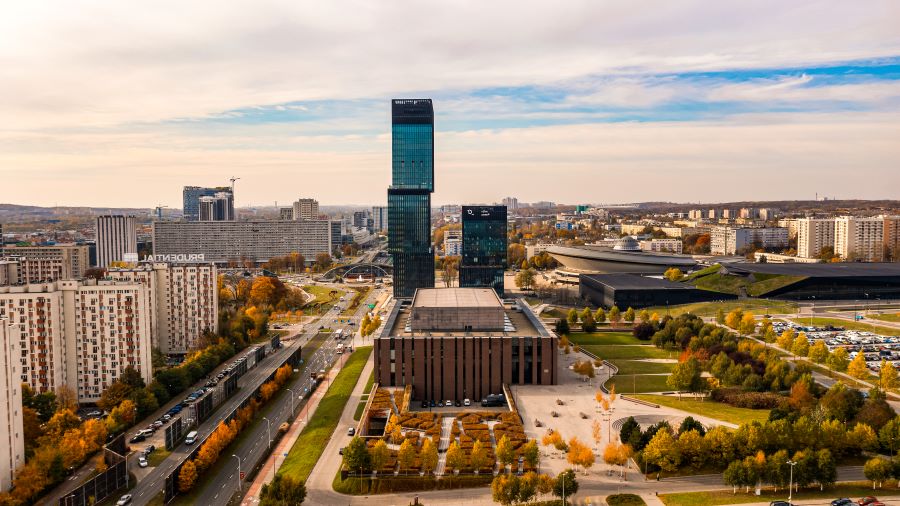| Tomek Grząślewicz |
They rise high up or spread out several hundred metres wide. Although they were built in different periods of time, each of them reflects its epoque and trends. Tomasz Kiełkowski, photographer, guide and graphic designer associated with the University of Silesia tells us about four characteristic buildings in Katowice – the city that has always wanted to be on time.
Skyscraper
A seventeen-storey building, popularly known as “Silesian Skyscraper” stands at ul. Żwirki i Wigury 15. At the time of its construction in the mid-1930s, it was the tallest building in Poland. Thanks to its steel skeleton structure and raw functionalist shell, it can be perceived as Katowice’s answer to American skyscrapers, which were built on a mass scale at that time. The building was one of the reasons why Katowice was nicknamed “Polish Chicago”. The tenant list of niebotyk, as it used to be called back then, did include some well-known names.
‘It was the most prestigious address in pre-war Katowice. Among those who lived here were Tadeusz Dobrowolski, the founder of Silesian Museum, and Marian Sobański, Director of the Silesian Theatre’ , emphasizes Kiełkowski.
Interestingly, the most important premises for operating the entire building was located at its very top. This is where the janitor lived. He was responsible for the lifts and central heating, the key facilities for the functioning of the high-rise building.
Old Railway Station
The railway station building at ul. Dworcowa, which is now a historic monument, is known among the people of Katowice as “old”. A little over a century and a half ago, when it was built, railway was the most powerful development engine for the young city, in line with the correct forecasts of visionaries such as Franz Winckler and Friedrich Wilhelm Grundmann. Thanks to it, the products of local coal mines and steel plants could be transported across Europe, and Katowice quickly took over as the capital of this part of the Upper Silesia from Bytom.
The old railway station, chronologically second in the city’s history, stopped serving its initial purpose over fifty years. The brutalist building which replaced it stood until the end of the first decade of the 21st century. Another one, already fourth in the history of the centre of Katowice, was built in its place ten years ago.
‘’The history of railway stations shows how a city needs modernity in order to develop. Katowice kept inflecting this modernity in all cases, at each stage of its development,’ comments the guide.
Unit
After 1945, a huge number of several storey-high residential blocks were built in Poland. However, not many of them are even close in its length to Superjednostka (Superunit) in Katowice, which spreads along al. Korfantego for almost 200 metres.
‘Superjednostka consists of nine blocks put together,’ says Kiełkowski. ‘The way this building was populated is also interesting: when one part was completed and people settled there, the other part was still under construction.’
The architectural background that Superjednostka originates from is quite difficult and requires knowledge of a broader context. It is a variation of the so-called “Unité d’Habitation”, i.e. the modernist residential building designed by French architect Le Corbusier. Although from today’s point of view the size of the flats seems to be very small, half a century ago Superjednostka was a real response to the challenges related to a large inflow of people from the countryside to the city.
‘In the 1970s, this is what modernity looked like,’ comments Tomasz Kiełkowski.
Office buildings
The latest edition of modernity in Katowice came into being at the turn of the second decade of the 21st century in the area which is full of older and newer architectural icons of the city, such as Spodek Arena, Silesian Insurgents’ Monument and the seat of the Polish National Radio Symphony Orchestra. The .KTW office buildings with glazed façades were erected at al. Roździeńskiego 1. At the moment they are the tallest buildings in Katowice and the entire Metropolis GZM. The emotions they raise among the inhabitants are not necessarily positive. However, the guide from Katowice claims that in such cases history really likes to repeat itself.
‘A majority of buildings that grow to be symbols of cities are regarded as controversial at the beginning. Silesian Skyscraper, Superjednostka and Spodek Arena were not highly praised by everyone at first. However, they smoothly became part of the Katowice space over time.
It is then likely that the same thing will happen to .KTW office buildings in a few years.
‘Katowice has wanted to be modern at each stage of its development,’ sums up Tomasz Kiełkowski. ‘Both at the very beginning of the 19th century, when Franz Winckler took over these areas, in the interwar period, after 1945, and right now – construction in this city is always up-to-date.
Video
Culture Zone in Katowice






